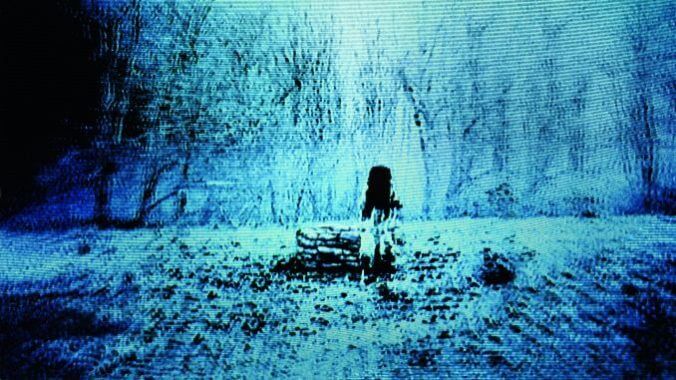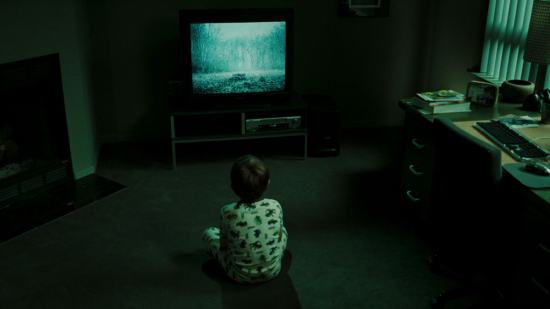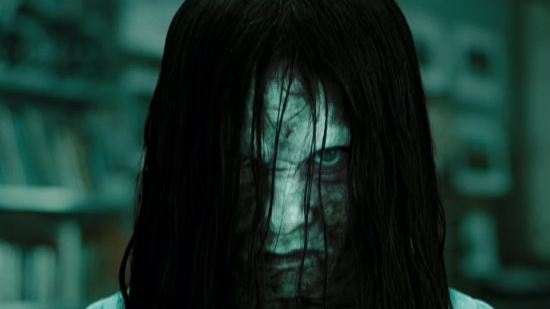The Ring Birthed American-Made J-Horror (And Buried VHS)
At 20, the Verbinski J-horror remake's influence has faded after bringing its sensibilities to America

The night I first saw The Ring, Gore Verbinski’s 2002 remake of the much-less-explicit 1998 Japanese film Ring, I walked back from an Ames, Iowa theater and had to cross a motorway bridge in the dark to get back to campus. It wasn’t really pedestrian-friendly, and I was obliged to turn myself sideways to squeeze between the car guardrail and the edge of the bridge, crab-walking along it as absolutely no cars drove by. So of course the question was: Do I put my back to the road, or to the creek below—a hole of darkness outside the glow of the street lamps, concealing the sound of rushing black water, framed by the grasping skeletal fingers of the bare trees on the banks? I went with the latter: It couldn’t be a good idea to leave my back turned to that, right?
It’s a dilemma that echoes the approaches of horror movies, isn’t it? Is it scarier to loom behind the audience’s back with threats of the unknowable, or to put entirely knowable threats square in front of their faces? Verbinski chose the latter approach, steering straight into the disturbing and grotesque with his remake of a cursed object and a vengeful spirit that punishes those who can’t overcome their curiosity. It’s a classic, universal premise, one the original used to create a low-key, understated experience that only used complicated visual effects when it had to. The Ring, conversely, is lurid and intense pretty much from the first scene to the very last. It’s shocking first, unsettling second, and it translated to a mini boom in remakes of Asian horror films, or properties that took cues from them.
At 20, though, it feels like another mega-hit success of Verbinski’s, Pirates of the Caribbean: An inescapable success at the box office that nonetheless feels as if the premise should just end with the first movie. It is deeply ironic that the pirate movie based on a Disney ride is the one that wormed its way into the minds of moviegoers and money men in Hollywood, spreading its sickness…

The Ring came out as VHS was truly dead: I was stocking shelves and emptying out the overnight returns box at a Blockbuster Video in 2001, and in my less-than-a-year of service, the New Releases walls went from boxes full of big chunky plastic bricks of magnetic tape to svelte ones, secured with magnetic locks to prevent the theft of the small, seemingly weightless optic discs. Besides the fact that the original Ring was also centered around a VHS tape, there’s really no question why the older technology was used in the remake that dropped just a handful of years later, on the other end of the technology’s rapid decline: A VHS tape is more tactile than a DVD, a thing you can nudge and affect, with little wheels and catches, with weight to the images and sounds inside that you can literally see through one little plastic window, coiled in a black mass around its spoke. It feels like a thing that can house malevolence, a thing that hands have touched.
The girls in the opening scene of The Ring, the ones who are menaced by the spirit inside a tape that, it is said, kills whoever watches it after seven days, are flipping through channels on an old tube set. There is a wired landline telephone in their house, with a curly-cue cord and all. It’s one of the last movies I can think of that occurred decidedly in the analog era—it should be watched in a double feature with The Blair Witch Project to really see how the end of the analog era simultaneously ushered in the beginning of the digital one.
These girls (very naturalistically…) start talking about the cursed tape at the center of the film. As it turns out, one of them has actually watched it. The scares in the first scene are a good harbinger for what’s to come: Every now and then a TV will turn on randomly, unbidden, the sort of on-set trickery that is creepy and also easily achieved without any complicated VFX. But then, there are also complicated VFX: Blurry reflections of dread in the glass, creeping dark water from under door frames and the digital morphing of the girl’s face in the one or two frames where we see what effect the curse has on her.
As it turns out, the slain teenager was the niece of hard-charging, I’m-not-fired-because-I’m-on-deadline reporter Rachel (Naomi Watts) whose performance is solid if a little cliched. At her grieving sister’s behest, Rachel takes on the case. Rachel is also navigating the fact that her dead niece had a close relationship with the son her work drives her to neglect, Aidan (David Dorfman, bringing a preternaturally creepy performance). Rachel catches wind of the urban legend surrounding the VHS tape that kills you when you watch it, and discovers that her niece’s entire friend group have met suspiciously synchronized fates. And so it comes off as somewhat heedless when she just goes and watches the tape herself, having located it on the shelf of a shared tape library in a scuzzy cabin deep in the gloom of the Pacific Northwest.
-

-

-

-

-

-

-

-

-

-

-

-

-

-

-

-

-

-

-

-

-

-

-

-

-

-

-

-

-

-

-

-

-

-

-

-

-

-

-

-









































